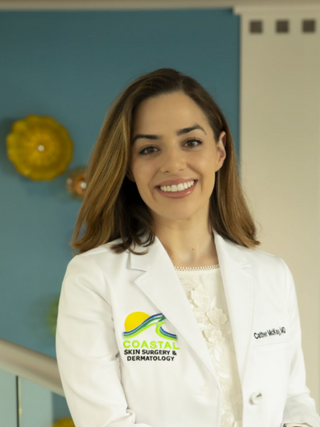In today's wellness collab we have Cather McKay MD, FAAD, is a board-certified dermatologist practicing in Fort Walton Beach, Florida. Dr. McKay completed her undergraduate education at Vanderbilt University, followed by medical school at the University of Alabama at Birmingham, and dermatology residency at Tulane University. She is an active member of the American Academy of Dermatology, the Women’s Dermatologic Society, and the Skin of Color Society. She is a skin care and sunscreen enthusiast, and strives to help patients feel their best in their skin.
Share your story and how you became a dermatologist?
I have known I wanted to become a doctor since I was a little girl. Growing up, both of my parents unfortunately experienced medical issues. We frequented doctors’ offices and hospitals. But most experiences were positive and these places and the doctors helping us represented hope and healing to me.
The decision to specialize in dermatology was made during my third year of medical school. I really enjoyed learning the basic science of how the human body functions, and in particular, the immune system. When I completed my dermatology rotation as a medical student, I was hooked. I was mesmerized by the complexity of the skin barrier and immune function in the skin, and still maintain a fascination and curiosity that keeps every day interesting.
Following medical school, I went on to complete four years of residency to specialize in dermatology. I am now in my third year of private practice. I very much enjoy being able to see children and adults, perform procedures and manage complex medical conditions, and develop long term patient relationships.
How does the sun affect the skin?
Ultraviolet (UV) radiation from sun has many effects on human skin, the most worrisome being DNA damage to our skin cells. DNA damage ultimately puts us at risk for skin cancer. Signs of DNA damage include both sunburn and tanning. Intense bursts of UV overwhelm the skin cells’ repair mechanisms, leading to sunburn from cell death. Lower amounts of UV also cause DNA damage, which causes skin cells to produce more melanin (seen as a tan) as a protective mechanism against further damage.
Sun exposure also causes profound changes in the appearance of our skin over time. Photoaging is the appearance of hyperpigmentation, brown spots, dilated blood vessels, and lines and wrinkles. In addition to damage to skin cells, UV radiation also penetrates the dermis and damages our collagen over time, leading to volume loss, thin skin, and easy bruising.
How much sunscreen do we need? When should I wear sunscreen and how often should we reapply?
Sun protection is important for everyone, regardless of skin type, geographic location, weather, or time of year. I recommend wearing sunscreen on exposed skin on a daily basis. For me, that means applying sunscreen with at least SPF 30 to the face, neck, chest, and hands every morning. I also use a hat and gloves while driving.
The amount of sunscreen needed to cover the face alone is a drop about the size of a nickel, or enough to fill the bottom of a shot glass. The amount needed to cover an average human body is 1 ounce, or 30 grams, which is enough to fill a shot glass. When outdoors, sunscreen should be reapplied every 2 hours at least. If swimming or sweating, a water-resistant sunscreen is a must, and these will say on the label how long they last when exposed to water (typically 40 or 80 minutes). I also love wearing hats, sunglasses, and sun-protective clothing for additional sun protection.
What ingredients should I look for in a sunscreen?
My preferred ingredients in sunscreen include zinc oxide, titanium dioxide, and iron oxide. These are ingredients in mineral (aka physical) sunscreens. These ingredients work by physically blocking or reflecting UV rays. Iron oxide is an ingredient which gives sunscreen a tint, often an option in facial sunscreens. Iron oxide has been shown to also block effects of visible light and blue light from our screens, which can contribute to photoaging and hyperpigmentation.
What’s the difference between natural sunscreen and chemical sunscreen?
Sunscreens can be categorized as mineral or chemical. Mineral sunscreens contain zinc oxide +/- titanium dioxide. These sunscreens are safe for babies over the age of six months and are best for sensitive skin. Chemical sunscreens contain a handful of ingredients that work by absorbing UV radiation to prevent damage to our skin cells.
The major downside of mineral sunscreen is the thick consistency of many brands. I encourage patients to try different brands until they find one they like. Chemical sunscreens are easier to apply as they rub in and are more often available as a spray.
Some controversy exists around chemical sunscreens due to the potential for absorption through the skin and possible damage to coral reefs when washed off into the ocean. Chemical sunscreens are still considered safe, but if you want to avoid these issues, consider opting for a mineral sunscreen.
Ice Breaker
Can’t skip daily habit?
Coffee. I absolutely love coffee and the ritual of that first cup in the morning sets the tone for my day.
Favorite book?
I really loved the Anne of Green Gables series growing up. I remember getting lost in those books for hours.
What makes you feel at peace?
Being on the couch with my dog and husband, wearing cozy pajamas with a warm blanket.
Best advice?
We only have one body- love and nurture it with healthful food, exercise, and of course, sun protection!
Favorite skincare tool?
I haven’t used many tools at home, but one of my favorite tools at work is our microneedling device to stimulate collagen production. I love that the downtime is typically just a weekend.
Ways to connect
You can find her on instagram @cathermckaymd or to see her as a patient, visit coastalskinsurgery.com.

